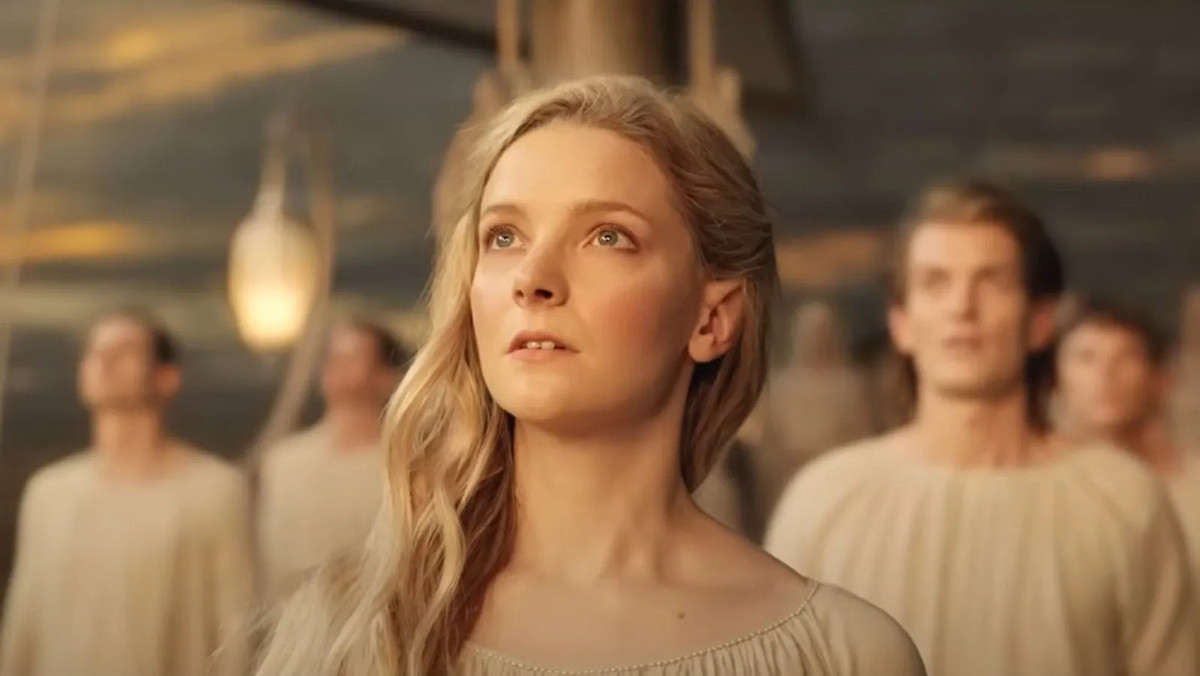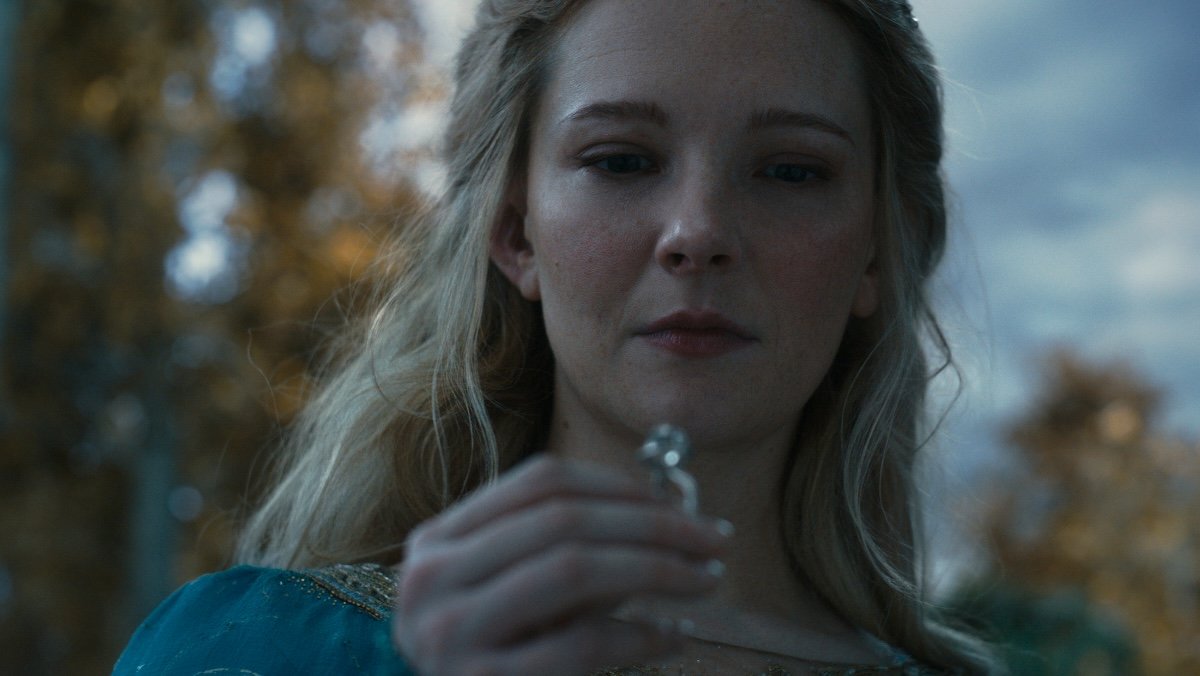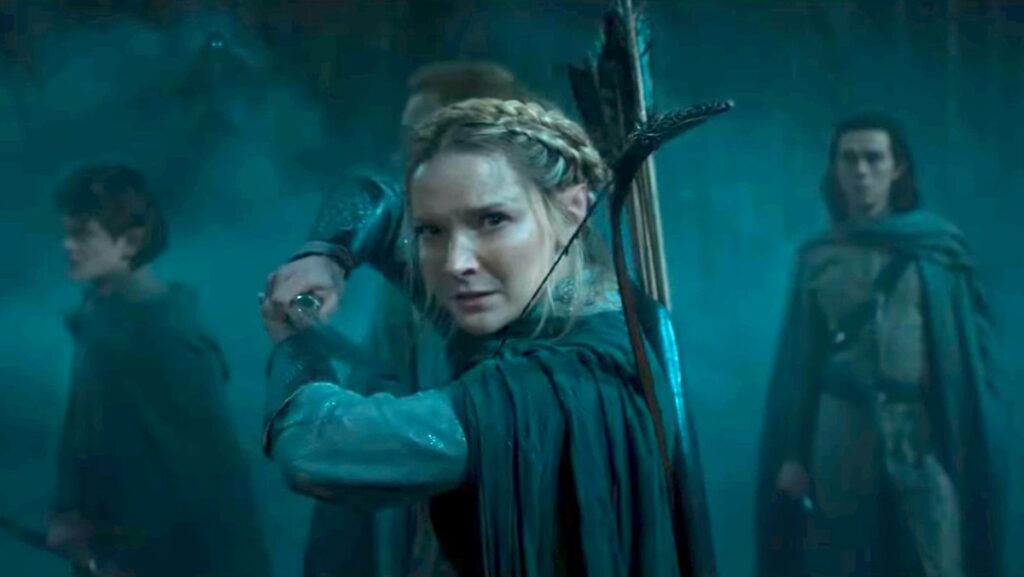As The Rings of Power moves through its second season on Prime Video, the show continues to expand on the lore of Middle-earth in its Second Age, with the threat of Sauron coming ever closer to everyone. This season began with Sauron’s deception as Halbrand is revealed to the elves of Lingon after the creation of the first three Rings of Power. Gil-Galad, Círdan, and Galadriel have now become the first ringbearers.
Galadriel in particular, as the story’s primary focus, has made a compelling case for The Rings of Power as a worthy adaptation which expands her as a character. We saw her become very close to Halbrand (a.k.a. Sauron) in the first season. Now, we are witnessing her deal with the ramifications of that this season. This character arc adds complexity to Galadriel, a figure who has only really been seen as the beautiful and graceful Lady of Lothlorien.
In the series, she transforms into a headstrong, ambitious warrior who will fight to protect her people from harm at any cost. This is especially intriguing considering what she becomes in the Third Age and The Lord of the Rings trilogy. Sadly, The Rings of Power continues to receive unnecessarily vitriolic backlash from racist and misogynistic “fans” online. Middle-earth reflects our world and they don’t like it. Along with adding more diversity, the show also adds more to existing characters in the Tolkien canon. Although Tolkien’s work has several mentions of Galadriel’s power and beauty, The Rings of Power lets us see her battle prowess in action. It helps us understand why she poses such a threat to the likes of Sauron.
The corruption resulting from the desire for power is a theme that has always been core to Tolkien’s work. Quite a few figures in Tolkien’s world deal with this temptation towards darkness. However, it is almost always male figures who become corrupt in pursuit of power. Meanwhile, the female figures are either easily manipulated or captured and often reduced to damsels in distress. In The Rings of Power, we see Galadriel’s single-minded desire for power motivated by her concern for the preservation of her people. After Sauron’s deception, she succumbs to her temptation by wearing her ring Nenya. This brings her into focus at the center of major conflicts within Middle-earth in a novel way. The audience gets to experience the previously mentioned challenges through fresh eyes, thanks to Galadriel.
Galadriel receives one of the Rings because she is one of the greatest of the elves. This statement is according to the appendices of The Return of the King, from which The Rings of Power draws much of its inspiration. Aside from mentions of her cunning and wisdom in the books, we don’t get much exploration of her power in live-action depictions. The exception is when Frodo offers her the One Ring as he and his fellowship seek refuge in Lothloríen.
In this pivotal scene for her character, she says, “You will give me the Ring freely! In place of the Dark Lord you will set up a Queen. And I shall not be dark, but beautiful and terrible as the Morning and the Night! Fair as the Sea and the Sun and the Snow upon the Mountain! Dreadful as the Storm and the Lightning! Stronger than the foundations of the earth. All shall love me and despair!”
Aside from this one instance, Galadriel, like many other women (elven or otherwise) in Tolkien’s stories, is rarely seen as a leader in the major battles against Morgoth or Sauron, whether in the Silmarillion, or in the main The Lord of the Rings trilogy. Let’s be honest. Tolkien did not write women—whether human, elven, or dwarven (of which there were none originally)—to be warriors or leaders.
An illuminating example is that of Lúthien in the Silmarillion, the daughter of the great elven king Thingol who, along with her eventual husband Beren, subdued the great enemy Morgoth with nothing more than her voice. Despite her power and dedication to her husband’s quest to retrieve the precious Silmarils from Morgoth’s lair, Beren was concerned that he could not provide her with “home or honour or the fair things that are the delight of the queens of the Eldalië.”
There are few elven women more powerful than Lúthien in Tolkien’s canon. But even she fought reluctantly, rather than as someone who wanted to take part in battle against the evil Morgoth for the good of their world. However, in The Rings of Power, we not only see Galadriel fight bravely alongside her male counterparts, but we also see several other women become pivotal in the battles fought against Sauron, like Queen Miriel.
Tolkien wrote these books in the 1930s and ‘40s, depicting a fantasy land in which he likely never imagined there to be characters like those in The Rings of Power. And that’s understandable, considering the world at that time. As much as his writing, beautiful and lyrical, has stood the test of time, so should adaptations be allowed to update his work in a way that reflects the world we live in. The show certainly does take some liberties with the canon. In the case of Galadriel, that includes the questionable lack of her husband Celeborn and her daughter Celebrian. I am willing to wait to see that story in return for a character who is so much more interesting than the fair Lady of Lothloríen.

Galadriel plays an undeniably important role in the main trilogy of The Lord of the Rings. But, beyond some sage advice, gifts to the fellowship that are used in their battles, and one aforementioned scene in which the terrifying potential of her power is demonstrated, we don’t get much else. In The Silmarillion, most of what is written that drives the main plot is focused on her brother Finrod and the male members of her family. All that is said about Galadriel when the Noldor elves are deciding to leave Valinor, the heaven-like land of the Valar, is that she wants to rule a land of her own. She never actually speaks in those pivotal moments.
There is a portion of Unfinished Tales of Númenor and Middle-earth that focuses on Galadriel and Celeborn specifically, but even that does not expand on Galadriel’s involvement in the battles against Morgoth and Sauron. It mostly focuses on their eventual settlement in Lothloríen. The Rings of Power shows a Galadriel who is wise and beautiful. But we also get a fierce warrior who believes that she can make her people safe, no matter how great the sacrifice. Once Sauron reveals himself at the end of season one, we see Galadriel face a true test of her dedication to fighting the darkness.
Sauron conjures a vision of her brother to gain her as an ally. He manipulates her ambition and desire to save her people, offering her a position at her side as his queen, with a line in reference to The Fellowship of the Ring. She rejects him, a moment which shows us just how much of a threat to Sauron. She is the greatest ally and enemy he could have. But she still allows the forging of the rings. This shows that she (and others like her) can still face temptation towards the darkness, despite her best intentions.

In making an adaptation that reflects our world, The Rings of Power has breathed in new life into Tolkien’s work. A new approach to some characters can actually make for a very compelling story. The Rings of Power gives Galadriel a chance to do and be more than she was in the original The Lord of the Rings trilogy and The Silmarillion. She finally gets the respect that one of the most powerful elves in Middle-Earth deserves. Her journey as a fierce warrior who wrestles with the corruption that great power can incur is compelling.



